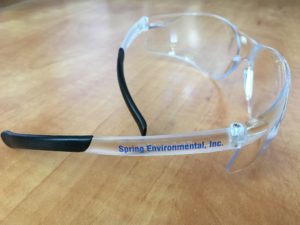Thank you for taking part in the Spring Environmental Monthly HAZWOPER challenge. By submitting correct answers to all 5 questions below on your initial attempt, you will be entered into our monthly drawing. This is an open book challenge. Please don’t hesitate to contact us if you have any questions.
Revised Construction Stormwater General Permits
Both the Environmental Protection Agency and Washington State Department of Ecology have revised Construction General Stormwater Permits to implement City and County of San Francisco v. EPA (2025), in which the Supreme Court found that end-result requirements, such as permit terms prohibiting discharges that contribute to a violation of a water quality standard in a receiving water, are unlawful.
On April 15, 2025, EPA published its final action, narrowly modifying the 2022 CGP under the CWA. The CGP modification expands the list of areas eligible for coverage, including construction projects that discharge to receiving waters within Lands of Exclusive Federal Jurisdiction. The modified CGP added new permit conditions applicable to Lands of Exclusive Federal Jurisdiction, which prohibit stormwater discharges that contain i) observable deposits of solids, scum, sheen, or other substances; ii) an observable film, sheen, or discoloration from oil and grease; or iii) foam or substances that produce an observable change in color, odor, or cloudiness in the discharge. EPA maintains that these “final water quality-based limitations” are valid because they “tie compliance to the condition of the discharge (not the receiving water).” The modified permit and Fact Sheet can be found here.
On March 19, 2025, Ecology published a proposal to update the 2021 CSWGP, which expires Dec. 31, 2025. The draft CSWGP proposes several changes including expressing that “end-result” prohibitions no longer apply, requiring that all site inspections (e.g. weekly) will need to be conducted by a Certified Erosion Sediment Control Lead (CESCL), requiring weekly sampling for either turbidity or transparency and weekly sampling for pH at construction sites 1-acre or less, requiring daily turbidity effluent limitation sampling for dewatering discharges to certain impaired water bodies, and dissolved oxygen impairments will trigger a numeric effluent limit for turbidity. Public comments are being accepted until May 9th. The proposed permit and Fact Sheet can be found here.
May HAZWOPER Challenge
April HAZWOPER Challenge
March HAZWOPER Challenge
February HAZWOPER Challenge
WA Ecology Publishes 2025 Industrial Stormwater Permit
The Washington State Department of Ecology (Ecology) published its final 2025 Industrial Stormwater General Permit (ISGP), which authorizes the discharge of stormwater and certain conditionally authorized “non-stormwater” discharges from industrial activities in the State of Washington. The final 2025 ISGP took effect on January 1, 2025 and superseded the 2020 ISGP.
The new permit:
- Prescribed quarterly 6PPDQ sampling requirement for Transportation, Postal Service (491xxx), Petroleum Bulk Stations and Terminals, Warehousing, and TSDF Facilities and Dangerous Waste Recyclers;
- Requires PFAS sampling requirements for facilities in the waste management sector and for air transportation facilities with known, current, or historical use of AFFF Foam;
- Eliminates automatic Conditional Non-Exposure approvals;
- Includes an Annual Gross Revenue Reporting obligation and a deadline of May 15; and
- Defines a new Level 3 Engineering Report Deadline of “no later than 6 months after the last day of the calendar year in which the Level 3 was triggered”.
Facilities previously covered under the 2020 ISGP had to reapply for coverage by July 5, 2024. Covered facilities must update their Stormwater Pollution Prevention Plans (SWPPP) to conform to the new permit by May 15, 2025, and all conforming SWPPP updates must be implemented by July 1, 2025.
More information is available at Ecology’s website here.
January HAZWOPER Challenge
Casey Sixkiller to be Director of Ecology
Governor-elect Bob Ferguson appointed Casey Sixkiller, current Regional Administrator of EPA and an enrolled citizen of the Cherokee Nation, as Director of the Washington State Department of Ecology effective January 15, 2025. Sixkiller’s appointment reflects Ferguson’s commitment to protect Washington’s clean air and water and create good-paying clean energy jobs across the state.
President Biden appointed Sixkiller to lead Region 10 in May 2022. Sixkiller oversees the EPA’s work to protect human health and the environment across the states of Washington, Oregon, Idaho, and Alaska, and 271 tribal nations, leading the EPA’s efforts locally to implement both the Bipartisan Infrastructural Law and Inflation Reduction Act, through investments in water infrastructure, addressing the impacts of climate change, and identifying solutions to achieve clean energy.

